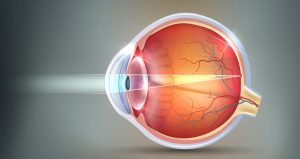Understanding The 4 Refractive Errors



Normal Eye

The eye focuses light like a camera. The cornea and lens of the eye focus light onto the macula, a part of the retina.
Myopia:

If an eye is too long, the image is focused in front of the macula, resulting is myopia, or nearsightedness. A nearsighted eye will have clearer vision at near than in the distance.
Hyperopia:

If the eye is too short, light is focused behind the macula, resulting in hyperopia, or farsightedness. A farsighted eye may be blurry at all distances, but distance vision is usually clearer than near.
Astigmatism:

Astigmatism results when the cornea has two different curvatures, like a football. Astigmatism degrades vision at all distances, making vision blurry at both distance and near.
Presbyopia:

Presbyopia occurs when an eye loses its ability to focus on near objects. This happens to all people by their mid-40s. Reading glasses or bifocals are commonly used to manage presbyopia.
Lasik and PRK can correct myopia, hyperopia, and astigmatism,but not presbyopia.
